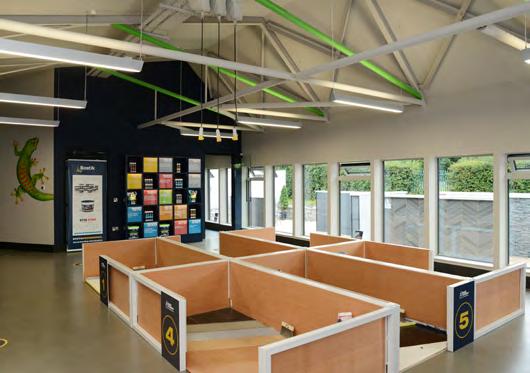
3 minute read
A State of the art in customer store experience
Case study: Castorama Poznan, Poland.
A few months ago, Castorama - part of the Kingfisher Group since 2001 (+1,350 outlets in eight countries - B & Q - Brico Depot - Screwfix - Koçtas ) - attracted a lot of attention in Europe with their very interesting ‘State of the Art in Customer Experience’ Case Study in Komorniki, a suburb of Poznan in Poland. This was a high-quality and promising investment in terms of new mobile phone technology assisting the customer experience. The testing phase which took place in the Castorama Poland store, is now over and more than 10,000 Poznan customers have downloaded and used this application during their shopping experience.
Partners in technology at the service of the customer
World player in lighting, Signify, (better known for its top brand Philips) and Polish mobile app maker Looksoft, joined forces to link their navigation system which is driven by mobile phone location technology and integrated it into the shop`s overhead lighting fixtures. This was then connected to the Castorama’s mobile application giving an ingenious interactive interplay with the main goal of optimising the customer’s shopping experience in a user-friendly way.
Retail experts explain
“This project represents a European first for the Home Improvement Industry and we look forward to rolling out this Indoor Navigation case study - after thorough evaluation - to the maximum extent,” confirms Gerben van der Lugt, Global Lead Indoor Location & Map Services at Signify Headquarters in Eindhoven, the Netherlands.
“Allow me to briefly explain the way it works: the power supply of all LED lighting fixtures (including downlights and spotlights), in this case a DIY store, can be equipped with Visible Light Communication (VLC). Each individual light point emits a unique `spill code` that a customer`s smartphone’s tiny camera can recognise. This technology then enables a connection between a customer`s smartphone camera acting as a light sensor and the VLC capturing light signals. Thanks to the connection between the light beam and the smartphone, it becomes possible to determine the location of the smartphone indicating where the customer is in the store.
Your customers smartphone as a shopping guide
Signify then developed software with two components: shop localisation (positioning based on the recognition of luminaires) and digital maps that indicate shop routes that calculate and indicate the route to a specific aisle or shelf in the store. In this way, the software leads the customer to one of the 35,000 SKUs, spread over + 5,000 m², that are available instore. The great benefit of VLC is that you do not have to have a substantial investment for such a navigation system because the store simply uses the existing lighting fixtures, without the need for additional energy sources or batteries.
Enhancing the customer journey
Designed by Polish mobile application developer Looksoft, the Castorama app acts as an instore navigation system similar to Google Maps or other GPS navigation systems. “In addition to its function as a map reader, the application also provides comprehensive product information for almost every one of its 35,000 SKUs and current promotions, complemented by a shopping list so that customers are also reminded of products that belong together (digital cross merchandising) when carrying out specific jobs (paint / paint brushes or wood battens / glue). All these shopping lists can be highlighted additionally during the navigation route on the way to the product. A promotion of a particular product can appear on the smartphone display exactly when the customer walks past it. The navigation system also supports shop staff in stocking the shop shelf,” points out Agata Iwanska, Business Development Manager CEE, Signify.” With this pioneering technology, we are contributing to the technological revolution in an enclosed shopping environment where navigation runs flawlessly, without the risk of signal interruptions or interfering with other technologies,”.
Self-reliance, the shopping credo
Multiple studies, including this one, by the Location Based Marketing Association (Canada), confirm that one of the biggest customer frustrations is that they have to leave a store because they can`t find a product. Such frustrations mean lost sales for retailers. With the breakthrough of ‘product finding ‘ by ‘self-search’, consumers are learning to embrace technology in an educationally responsible manner. Quite a few retailers recognise the added value of location-based retail marketing; more specifically, in terms of productivity and staff cost efficiency. Home Improvement Retail still has some catching up to do in terms of technology investments to precisely optimise customer centricity in the post-pandemic era where the BOPIS principle (Buy online, Pick up in store) is now entrenched. To illustrate and complement this, electronic price labelling is just as much a part of the solution. The next challenge, therefore, is to connect multiple technologies so that together they take the shopping experience to an unprecedented level. It seems logical that localisation, navigation, digitised price labelling, digital shop plans and planograms could soon all be interconnected to shop staff’s “to do list.”
A brighter future for Home Improvement
The power of Signify’s Indoor Navigation will certainly have an inspiring and cross-border effect for the other Kingfisher retail formats and also for all type of Home Improvement formats in Europe. In the context of the current economic climate, are all seeking solutions for the customer with reduced purchasing power and a shortage of skilled staff.











